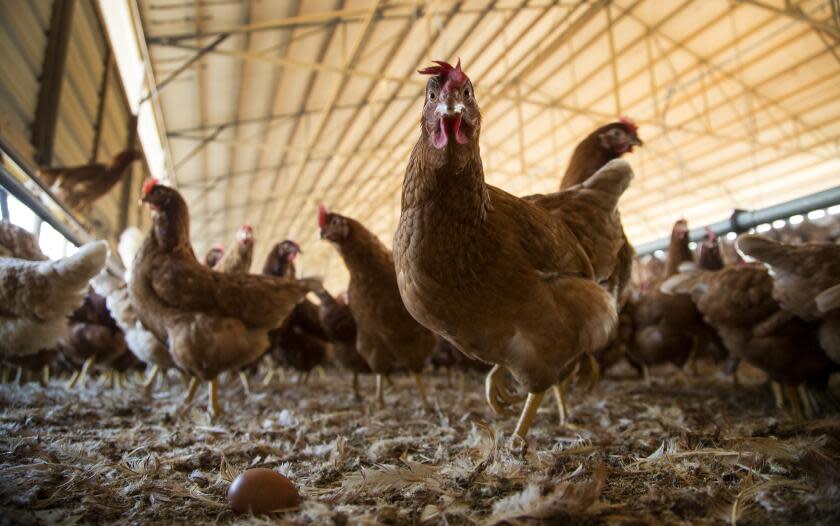Bird flu detected in San Francisco wastewater and chickens

As federal and state health officials expand their avian flu surveillance, the San Francisco Department of Public Health has reported that the virus has been detected in wastewater samples collected in May.
The samples were collected after two chickens at a live bird market in the city tested positive for the disease May 9.
Authorities say that the source of the virus, H5N1, in San Francisco's wastewater is unclear and that the city's sewer system incorporates both wastewater and stormwater — meaning it could be coming from animal waste, milk, people or a combination of sources.
City officials said the virus has not been detected in more recent wastewater analyses, which have been analyzed by WastewaterSCAN, an infectious disease monitoring network run by researchers at Stanford, Emory University and Verily, Alphabet Inc.’s life sciences organization.
Read more: What you need to know about the bird flu outbreak, concerns about raw milk, and more
WastewaterSCAN and the Centers for Disease Control and Prevention recorded a Bay Area spike of Influenza A activity during April and May. The avian flu is an influenza A subtype.
In May 2024, the city was informed by the California Department of Public Health of a positive H5N1 test result on two asymptomatic chickens at a market in San Francisco. The test was conducted as part of the state's routine testing of live bird markets.
San Francisco's Department of Public Health began daily monitoring of market employees who were in close contact with the live chickens. No symptoms were reported, and the market has reopened.
It was during this period that WastwaterSCAN tested wastewater samples and found fragments of the avian flu genetic material.
According to a Health Commission Director’s Report for the city, San Francisco is the only municipality in California so far with a positive H5N1 avian flu detection.
Cities in other states, including nine in Texas, have had detections.
The avian flu, which saw a North American resurgence beginning in February 2022, is believed to have jumped from wild birds to dairy cows late last year. As of Monday, the disease had been detected in 79 dairy herds across nine states.
No infected dairy cows in California have been detected.
Read more: Despite the spread of bird flu, lawmakers in some states are pushing to legalize raw milk
Tests of commercial milk conducted last month showed genetic fragments of the virus in 20% of samples. It has also been detected in meat.
Health officials say pasteurization kills the virus; however, high levels have been found in raw milk — and cats and mice that drank raw milk from infected cows had high mortality rates.
Four people have contracted the disease in the United States; three were dairy workers.
Since 2022, hundreds of millions of birds have been infected with the disease across the U.S. In California, roughly 7 million commercially reared chickens, turkeys and ducks have been culled as a result of infection since February 2022.
Waves of the virus follow migrating birds and appear to peak during the fall, when birds that have been feeding all summer in the Arctic — and mixing with others from around the world — head south.
In an effort to contain the disease and prevent its spread, California's state veterinarian, Annette Jones, has periodically issued temporary waivers to free-range, cage-free and organic poultry farms, allowing farmers to keep birds indoors as the virus spreads.
It is unclear how many farms have taken advantage of the waiver, nor where the facilities, which are not designed to house indoor flocks, would keep the birds.
Jones said such a scenario was "unlikely because it's a recommendation, and I know a lot of people don't do that, because their facilities are not designed for it."
Read more: Are pet dogs and cats the weak link in bird flu surveillance?
Caleb Barron, an organic chicken producer at Fogline Farm in Pescadero, said he has not brought his birds indoors, and they have stayed disease-free. He said his biosecurity protocols — such as washing shoes and equipment — and ample spacing have provided protection from the disease.
"These other farmers, they see these birds as product. Do everything you can to keep your product safe," he said. "I guess we just see it differently."
According to the U.S. Department of Agriculture, in the last 30 days, the avian flu has been detected in 14 commercial and backyard flocks (5.82 million birds) in Minnesota and Iowa. The federal website says that ultimately 700 birds were involved in the San Francisco outbreak.
This story originally appeared in Los Angeles Times.


